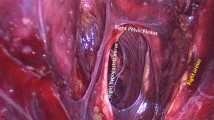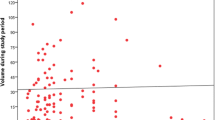Abstract
Purpose
To evaluate the feasibility and safety of laparoscopic excision of endometriotic lesions in obese women.
Methods
Retrospective analysis of prospectively collected data involving consecutive women scheduled for complete laparoscopic removal of macroscopic endometriotic lesions between January 2012 and November 2018. Operative time, laparotomic conversion rates, complication rates, and length of hospital stay were recorded.
Results
One thousand two hundred thirty women were enrolled and divided into two main groups, according to the World Health Organization classification of obesity, obese (body mass index ≥ 30 kg/m2) and non-obese (body mass index < 30 kg/m2). During the study period, 91 (7.4% of overall study cohort) obese women underwent surgery. At univariate analyses, significant differences between the two groups were found in terms of age, rates of severe endometriosis, American Society of Anesthesiologists physical status classification ≥ III, and different surgical procedures. Significant differences in terms of median operative time [125 (interquartile range (IQR) 85–165) in obese group vs 110 min (IQR 75–155) in non-obese group, P = 0.04] were observed. There were no significant differences between the obese and non-obese groups with respect to the other variables of interest. After adjusted multivariable regression models for potential confounders, difference in operating time (coefficient of 13.389; 95% CI 1.716, 25.060) was still found to be significant.
Conclusion
In our tertiary care referral center, laparoscopic removal of endometriosis is feasible and safe, except for a slight increase of operative time and conversion rate.
Similar content being viewed by others
References
Giudice LC, Kao LC (2004) Endometriosis. Lancet 364:1789–1799. https://doi.org/10.1016/S0140-6736(04)17403-5
Holdsworth-Carson SJ, Dior UP, Colgrave EM et al (2018) The association of body mass index with endometriosis and disease severity in women with pain. J Endometriosis Pelvic Pain Disord 10:79–87. https://doi.org/10.1177/2284026518773939
Vitonis AF, Baer HJ, Hankinson SE et al (2010) A prospective study of body size during childhood and early adulthood and the incidence of endometriosis. Hum Reprod 25:1325–1334. https://doi.org/10.1093/humrep/deq039
Liu Y, Zhang W (2017) Association between body mass index and endometriosis risk: a meta-analysis. Oncotarget. https://doi.org/10.18632/oncotarget.14916
Seracchioli R, Mabrouk M, Guerrini M et al (2008) Dyschezia and posterior deep infiltrating endometriosis: analysis of 360 cases. J Minim Invasive Gynecol 15:695–699. https://doi.org/10.1016/j.jmig.2008.07.005
Mabrouk M, Montanari G, Di Donato N et al (2012) What is the impact on sexual function of laparoscopic treatment and subsequent combined oral contraceptive therapy in women with deep infiltrating endometriosis? J Sexual Med 9:770–778. https://doi.org/10.1111/j.1743-6109.2011.02593.x
Villa G, Mabrouk M, Guerrini M et al (2007) Relationship between site and size of bladder endometriotic nodules and severity of dysuria. J Minim Invasive Gynecol 14:628–632. https://doi.org/10.1016/j.jmig.2007.04.015
Di Donato N, Montanari G, Benfenati A et al (2014) Prevalence of adenomyosis in women undergoing surgery for endometriosis. Eur J Obstet Gynecol Reprod Biol 181:289–293. https://doi.org/10.1016/j.ejogrb.2014.08.016
MacDonald KG (2003) Overview of the epidemiology of obesity and the early history of procedures to remedy morbid obesity. Arch Surg 138:357–360. https://doi.org/10.1001/archsurg.138.4.357
Hediger ML, Hartnett HJ, Louis GMB (2005) Association of endometriosis with body size and figure. Fertil Steril 84:1366–1374. https://doi.org/10.1016/j.fertnstert.2005.05.029
Heard ME, Melnyk SB, Simmen FA et al (2016) High-fat diet promotion of endometriosis in an immunocompetent mouse model is associated with altered peripheral and ectopic lesion redox and inflammatory status. Endocrinology 157:2870–2882. https://doi.org/10.1210/en.2016-1092
Scheib SA, Tanner E, Green IC, Fader AN (2014) Laparoscopy in the morbidly obese: physiologic considerations and surgical techniques to optimize success. J Minim Invasive Gynecol 21:182–195. https://doi.org/10.1016/j.jmig.2013.09.009
Camanni M, Bonino L, Delpiano EM et al (2010) Laparoscopy and body mass index: feasibility and outcome in obese patients treated for gynecologic diseases. J Min Invasive Gynecol 17:576–582. https://doi.org/10.1016/j.jmig.2010.04.002
Halder GE, Salemi JL, Hart S, Mikhail E (2017) Association between obesity and perioperative morbidity in open versus laparoscopic sacrocolpopexy. Female Pelvic Med Reconstr Surg 23:146–150. https://doi.org/10.1097/SPV.0000000000000382
Blikkendaal MD, Schepers EM, van Zwet EW et al (2015) Hysterectomy in very obese and morbidly obese patients: a systematic review with cumulative analysis of comparative studies. Arch Gynecol Obstet 292:723–738. https://doi.org/10.1007/s00404-015-3680-7
Uccella S, Bonzini M, Palomba S et al (2016) Impact of obesity on surgical treatment for endometrial cancer: a multicenter study comparing laparoscopy vs open surgery, with propensity-matched analysis. J Minim Invasive Gynecol 23:53–61. https://doi.org/10.1016/j.jmig.2015.08.007
Dindo D, Demartines N, Clavien P-A (2004) Classification of surgical complications: a new proposal with evaluation in a cohort of 6336 patients and results of a survey. Ann Surg 240:205–213. https://doi.org/10.1097/01.sla.0000133083.54934.ae
Seracchioli R, Ferrini G, Montanari G et al (2015) Does laparoscopic shaving for deep infiltrating endometriosis alter intestinal function? A prospective study. Aust N Z J Obstet Gynaecol 55:357–362. https://doi.org/10.1111/ajo.12358
Mabrouk M, Raimondo D, Altieri M et al (2019) Surgical, clinical, and functional outcomes in patients with rectosigmoid endometriosis in the gray zone: 13-year long-term follow-up. J Minim Invasive Gynecol 26:1110–1116. https://doi.org/10.1016/j.jmig.2018.08.031
Seracchioli R, Mannini D, Colombo FM et al (2002) Cystoscopy-assisted laparoscopic resection of extramucosal bladder endometriosis. J Endourol 16:663–666. https://doi.org/10.1089/089277902761403014
Seracchioli R, Raimondo D, Di Donato N et al (2015) Histological evaluation of ureteral involvement in women with deep infiltrating endometriosis: analysis of a large series. Hum Reprod 30:833–839. https://doi.org/10.1093/humrep/deu360
Tomescu DR, Popescu M, Dima SO et al (2017) Obesity is associated with decreased lung compliance and hypercapnia during robotic assisted surgery. J Clin Monit Comput 31:85–92. https://doi.org/10.1007/s10877-016-9831-y
Wysham WZ, Kim KH, Roberts JM et al (2015) Obesity and perioperative pulmonary complications in robotic gynecologic surgery. Am J Obstet Gynecol 213:33.e1–33.e7. https://doi.org/10.1016/j.ajog.2015.01.033
Meininger D, Zwissler B, Byhahn C et al (2006) Impact of overweight and pneumoperitoneum on hemodynamics and oxygenation during prolonged laparoscopic surgery. World J Surg 30:520–526. https://doi.org/10.1007/s00268-005-0133-7
Ng M, Fleming T, Robinson M et al (2014) Global, regional, and national prevalence of overweight and obesity in children and adults during 1980–2013: a systematic analysis for the Global Burden of Disease Study 2013. Lancet 384:766–781. https://doi.org/10.1016/S0140-6736(14)60460-8
Yi KW, Shin J-H, Park MS et al (2009) Association of body mass index with severity of endometriosis in Korean women. Int J Gynaecol Obstet 105:39–42. https://doi.org/10.1016/j.ijgo.2008.11.001
Author information
Authors and Affiliations
Contributions
Conceptualization: DR. Methodology: IR, MP. Formal analysis and investigation: GM, EDE, MM. Writing—original draft preparation: DR, AA, GB. Writing—review and editing: MM, SDF. Supervision: RS, SD.
Corresponding author
Ethics declarations
Conflict of interest
The authors declare that they have no conflicts of interest and nothing to disclose.
Informed consent
Informed consent was obtained from all individual participants included in the study at time of preoperative evaluation.
Additional information
Publisher's Note
Springer Nature remains neutral with regard to jurisdictional claims in published maps and institutional affiliations.
The study was registered on ClinicalTrial.gov with the following ID number: NCT0389935 (https://clinicaltrials.gov/ct2/show/NCT03899935).
Rights and permissions
About this article
Cite this article
Raimondo, D., Raimondo, I., Degli Esposti, E. et al. Feasibility and safety of laparoscopic approach in obese patients with endometriosis: a multivariable regression analysis. Arch Gynecol Obstet 302, 665–670 (2020). https://doi.org/10.1007/s00404-020-05629-9
Received:
Accepted:
Published:
Issue Date:
DOI: https://doi.org/10.1007/s00404-020-05629-9




